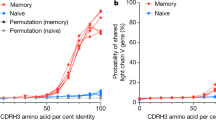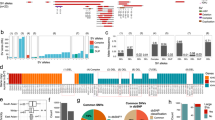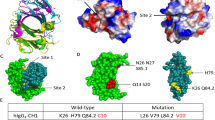Abstract
Immunoglobulin diversity seems to arise largely by three mechanisms: (1) the existence of several germ-line genes, which must be rearranged before expression—that is, V and J for the light (L) chains1–3, V, D and J for the heavy (H) chains4; (2) somatic events, including mutations and gene conversion5–8; and (3) combinatorial association of heavy and light chains9–13, leading to the proposal that random pairing of p × H and q × L chains might generate p × q antibody molecules expressing discrete specificities. As heavy and light chains derived from the same immunoglobulin molecule would frequently reassociate preferentially14–17, it is likely that only a fraction of potential heavy–light pairs actually provides ‘valid’ antibodies. As a consequence of combinatorial heavy–light chain pairing, antibodies of discrete specificities sharing the same VH region, associated with distinct light chains (or vice versa) should be encountered. We report here that two heavy chains, derived from the same VH germ-line gene, may be present in anti-NP or anti–GAT antibodies, depending on their association with a specific λ or κ light chain, respectively.
This is a preview of subscription content, access via your institution
Access options
Subscribe to this journal
Receive 51 print issues and online access
$199.00 per year
only $3.90 per issue
Buy this article
- Purchase on SpringerLink
- Instant access to full article PDF
Prices may be subject to local taxes which are calculated during checkout
Similar content being viewed by others
References
Brack, C., Hirama, M., Lenhard-Schuller, R. & Tonegawa, S. Cell 15, 1–14 (1978).
Sakano, H., Hüppi, K., Heinrich, G. & Tonegawa, S. Nature 280, 288–294 (1979).
Seidman, J. G., Max, E. E. & Leder, P. Nature 280, 370–375 (1979).
Early, P., Huang, H., Davis, M., Calame, K. & Hood, L. Cell 19, 981–992 (1980).
Bothwell, A. L. et al. Cell 24, 625–637 (1981).
Crews, S., Griffin, J., Huang, H., Calame, K. & Hood, L. Cell 25, 59–66 (1981).
Baltimore, D. Cell 24, 592–594 (1981).
Clarke, S. H., Claflin, J. L. & Rudikoff, S. Proc. natn. Acad. Sci. U.S.A. 79, 3280–3284 (1980).
Franek, F. & Nezlin, R. S. Folia microbiol., Praha 8, 128–130 (1963).
Edelman, G. M., Olins, D. E., Gally, J. A. & Zinder, N. Proc. natn. Acad. Sci. U.S.A. 50, 753–761 (1963).
Fougereau, M., Olins, D. E. & Edelman, G. M. J. exp. Med. 120, 349–358 (1964).
Metzger, H., Wofsy, L. & Singer, S. J. Proc. natn. Acad. Sci. U.S.A. 51, 612–618 (1964).
Amzel, L. M., Poljak, R., Saul, F., Varga, J. & Richards, G. Proc. natn. Acad. Sci. U.S.A. 71, 1427–1431 (1974).
Metzger, H. & Mannik, M. J. exp. Med. 120, 765–782 (1964).
De Préval, C. & Fougereau, M. J. molec. Biol 102, 657–678 (1976).
Klein, M., Kortan, C., Kells, D. I. C. & Dorrington, K. J. Biochemistry 18, 1473–1481 (1979).
Kranz, D. M. & Voss, E. W. Jr Proc. natn. Acad. Sci. U.S.A. 78, 5807–5811 (1981).
Ju, S. T. et al. Proc. natn. Acad. Sci. U.S.A. 76, 2942–2946 (1979).
Pierres, et al. Proc. natn. Acad. Sci. U.S.A. 76, 2425–2429 (1979).
Sommé, G. et al. Molec. Immun. 19, 1011–1019 (1982).
Sanger, F., Nicklen, S. & Coulson, A. R. Proc. natn. Acad. Sci. U.S.A. 74, 5463–5467 (1977).
Hamlyn, P. H., Brownlee, G. G., Cheng, C. C., Gait, M. J. & Milstein, C. Cell 15, 1067–1075 (1978).
Jack, R. S., Imanishi-Kari, T. & Rajewsky, K. Eur. J. Immun. 8, 559–565 (1977).
Ruf, J. et al. Proc. natn. Acad. Sci. U.S.A. (in the press).
Auffray, C., Sikorav, J.-L., Ollo, R. & Rougeon, F. Ann. Immun. 132D, 77–88 (1981).
Kabat, E. A., Wu, T. T. & Bilofsky, H. Sequences of Immunoglobulins (NIH Publ. no. 80-2008, 1979).
Tonnelle, C., Pierres, M., Ju, S. T., Moinier, D. & Fougereau, M. Molec. Immun. 18, 979–984 (1981).
Podell, D. N. & Abraham, G. N. Biochem. biophys. Res. Commun. 81, 176–185 (1978).
Auffray, C. & Rougeon, F. Eur. J. Biochem. 107, 303–314 (1980).
Kaartinen, M. et al. Immunology (in the press).
Lazure, C., Tung-Hum, W. & Gibson, D. M. J. exp. Med. 154, 146–155 (1981).
Author information
Authors and Affiliations
Rights and permissions
About this article
Cite this article
Rocca-Serra, J., Tonnelle, C. & Fougereau, M. Two monoclonal antibodies against different antigens using the same VH germ-line gene. Nature 304, 353–355 (1983). https://doi.org/10.1038/304353a0
Received:
Accepted:
Issue date:
DOI: https://doi.org/10.1038/304353a0
This article is cited by
-
The immune system and lymphoma
La Ricerca in Clinica e in Laboratorio (1987)



